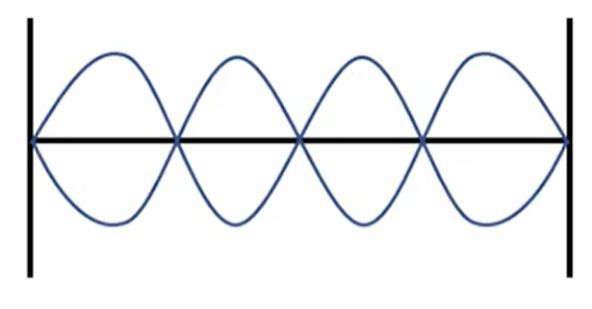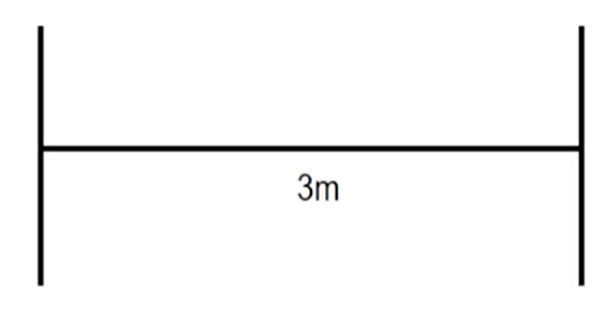Guys, in earlier videos, we saw that waves can interfere with each other. In this video, I'm going to show you that in some cases, waves can interfere in a special way to produce a special type of wave called a standing wave. I'm going to introduce you to transverse standing waves on strings. Now there's a lot of conceptual information to understand here, but the hardest thing about standing waves is understanding what exactly is going on. I'm going to break it down for you guys and show you exactly what a standing wave is. To do that, I'm basically going to show you 3 different scenarios to understand what a standing wave is all about. Let's go ahead and take a look here.
So, what I want you to do is imagine that you have a string in your hand that you're whipping up and down and that the string is tied to a fixed end like a doorknob. Your oscillator, the thing that's moving up and down, is your hand and it's tied to the doorknob. Let's take a look at the first scenario here. You're going to take the string and whip it up just once. You're going to create a single pulse that moves to the right. What happens when that pulse actually reaches the doorknob? You have this pulse that reached the doorknob like this, and that disturbance has to go somewhere. Basically, the doorknob is going to flip this pulse upside down and now this pulse is going to be going backwards. In general, when a traveling wave reaches a fixed endpoint like a doorknob, it's going to create a reflected wave or pulse that travels backwards, but it's going to be inverted.
Now, let's take a look at the second one. Now you have the string and instead of whipping it up twice or once, you're just going to whip it up and down once to create a single wave. You're going to wait a few seconds and create another up and down to create two waves here. So you have two waves moving to the right. What happens later on? Well, basically the right wave is going to hit the doorknob first, and it's going to invert, and now it's going to travel to the left. The left wave is still moving to the right. So the left wave is going to be over here, and it's going to have traveled to the right like this, and you're going to end up with a wave pattern that looks like this. You have these two waves now that are sort of moving towards each other, and they're going to interfere. You end up with the superposition of these waves, and it's going to look something like this. It's going to look like a wave pattern. For most frequencies that you whip the string up and down, the waves are going to interfere somewhat randomly, creating a jumbled mess that does not create any sort of pattern.
Now, let's take a look at the third scenario. Change your frequency, go a little bit slower or faster, and what happens is that for very special frequencies, you're going to create some interesting patterns. If you slow down your wiggle and create a single arc that goes from left to right from your hand all the way to the doorknob, when it reaches the doorknob, it's going to flip upside down, it's going to go backwards like this. If you keep this frequency, you're basically going to create a wave that looks as if it's just going up and down, but it's not actually moving left to right. It kind of looks like a jump rope if you were to look at it from the side. For very special frequencies, you're going to create an interference pattern that's very special and you generate a wave that looks as if it's stationary. Because this wave looks as if it's standing still, we call it a standing wave. That's what a standing wave is. It's just a special wave pattern that you get for a very special frequency. This doesn't happen for all frequencies. As we saw in the second example here, for any sort of general frequency, you're going to create a jumbled mess of waves that interfere randomly.
Let's talk about these frequencies. We said that there's a very special frequency, but there's actually an infinite number of these special frequencies that create standing waves. If I start off from this pattern here and I take the string and whip it up and down even faster, eventually, I'm going to create another pattern in which I have a single wavelength along the string. When it reaches the doorknob, it's going to invert and it's going to travel backwards, and you're going to create another standing wave pattern that's going to look like this. It's going to have this weird sort of loopy pattern. If you vibrate this even faster, you're going to create another standing wave pattern where you have three loops, then four and so on. Here, the letter \( n \) is the number of loops in our standing wave pattern. For the most basic one that we created, we have one loop, and for this one, we have two pairs of loops, and this is \( n = 2 \) and then you get \( n = 3 \), and so on.
The most important frequency that you need to know is called the fundamental frequency, which is given by the letter \( f_1 \). It's the frequency where \( n = 1 \). Anytime you see the fundamental frequency, it just means that \( n = 1 \). It's the frequency that you need to whip the string up and down so you can create this pattern right here, the most basic type of standing wave. The reason this fundamental frequency is important is that once you figure that out, you can actually figure out all of the other harmonic frequencies. Harmonic frequencies are just the other frequencies for all other standing wave patterns that you can possibly get where you have more than one loop, and they're basically just multiples of this fundamental one. The general equation you're going to see is that \( f_n \), for any number of loops, is just going to be \( n \times f_1 \).
Let's go ahead and take a look at an example here. We have a string between two supports and it vibrates in a standing wave pattern. We have three loops right here. In the first part, we want to draw a sketch of the wave. So for this first part here, we have \( n = 3 \). What does it tell us? Remember, \( n \) is just the number of loops. We have three loops where we have \( n = 3 \). A sketch of this wave would look like this. We're going to have one loop, this is going to be the second loop, and this is going to be the third one. The frequency of the standing wave pattern is 15 Hertz. Because \( n = 3 \), what they're saying is that \( f_3 \) is equal to 15 Hertz. Now, in the second part, we are asked to find out what the fundamental frequency is. Remember, anytime you see the word fundamental, what that means is that \( n = 1 \). If \( n = 1 \), what they're asking us is what is \( f_1 \) right here? Using the equation \( f_3 = 3 \times f_1 \), we can solve for \( f_1 \), which is \( 15 \div 3 = 5 \) Hertz. To create a standing wave pattern with three loops, you'd have to vibrate the string up and down at 15 Hertz. But to create a standing wave pattern with just one loop, you'd have to slow down that frequency and pulse the string at 5 Hertz to create a more simple wave pattern. Now let's look at the frequency for a standing wave with five loops. They're stating that \( n = 5 \). So what is \( f_5 \)? We're going to use this equation right here, \( n \times f_1 \). So the idea here is that you'd have \( 5 \times 5 \) Hertz, and you get 25 Hertz. Every time you add 5 Hertz, you vibrate the string 5 Hertz faster, and you end up with one more loop in your standing wave pattern. That's it for this one guys. Let me know if you have any questions.



